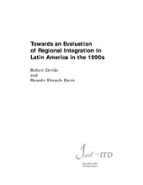Towards an Evaluation of Regional Integration in Latin America in the 1990s
Date issued
Dec 1998
Subject
Investment;
Integration and Trade;
Globalization and Regionalization
Category
Working Papers
The decade of the 1990s has witnessed a wave of regional integration initiatives in Latin America: more than 14 agreements -free trade areas or customs unions- since 1990 with a handful more in varying degrees of negotiation (see Table 1). However, this was not just a Latin American phenomenon, as regionalism has more than ever become a global trend (Mistry [1996]). Indeed, now Japan, South Korea and Hong Kong are the only World Trade Organization (WTO) members which are not signatories to at least one preferential trade agreement (WTO [1995]). Regional integration is not new to Latin America. Economic integration played an important role in the region¿s early Post-War economic history. The 1960s and 1970s saw a number of very ambitious initiatives inspired by the successful Western European experience (Ffrench-Davis, Muñoz and Palma [1994]). Indeed, at its peak in the late 1960s and early 1970s, the topic of integration was hard to avoid in the discussion of Latin American development. However, disillusionment with integration processes had clearly set in by the late 1970s and the discussion of regional integration was all but silenced by the external crisis of the early 1980s.



